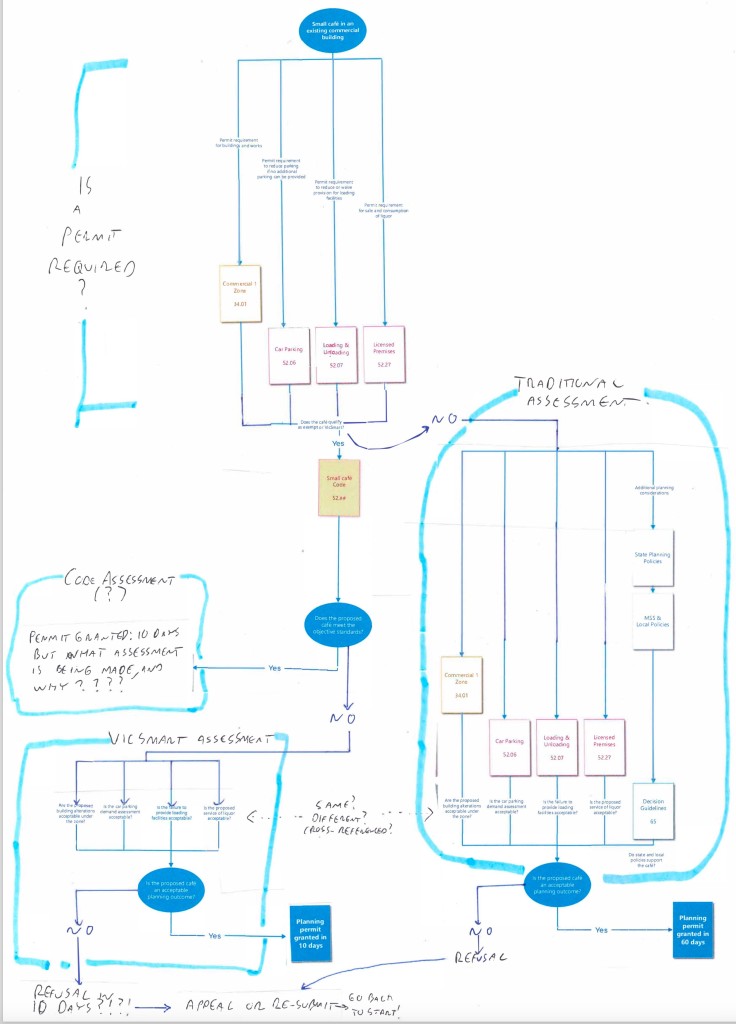This piece was written for the December 2017 issue of Planning News.
By the time you read this the Smart Planning program will have completed its consultation period after the release of its October discussion paper on the VPPs. The state government will be attempting to roll out its reforms exceptionally quickly, with some material promised by the end of the year and gazettal of a final package of VPP reforms expected by July.
It’s a nerve-rackingly short timeframe. The pace of change invites doubt about the genuineness of the consultation – is there really scope to stop, think, and potentially change course if the consultation raises legitimate issues about the package proposed? Is it long enough to sufficiently “debug” a complex set of changes? I fear not. This is, unfortunately, a deeply problematic set of reforms.
The problem with system reform like this is it all sounds great – yay! Smart! – but the problems are in the detail. This is why the timeframe allowed for the reforms is so challenging; it is also why it is difficult to unpack the issues with this paper in the space available here. Suffice, then, to make a few key points.
Diagnosis Precedes Cure
The paper – and the limited material released earlier in the process – is remarkably devoid of specific diagnosis of problems. The system is described as slow and complex, but there is little attempt to analyse exactly why that is. The detailed analysis that the Underwood review started with has not been attempted again, and the Smart Planning work makes few references to it.
As a result, there is often a mismatch between problems described and the fixes outlined. The system is too complex; but many more use-based codes are to be added. The structural problems created by VicSmart are (finally) acknowledged; but the system massively increases the reliance that structure. Assessment should be proportional, related to the complexity of issues raised by a proposal; yet it is proposed to move away from the inherently proportional issue-based structure towards increased reliance on non-proportional category-based provisions. And so on.
This unfocussed discussion of system problems leads to a reliance on two big ideas: category-based code provisions and an integrated PPF. Neither seems to me well-suited to fixing the VPP’s real problems.
Category-Based Code Provisions
The proposed system is heavily dependent on a series of category-based codes that will override other provisions of the scheme for designated application types. The theory obviously is that this structure allows an easier entry to the system, since proponents of a particular proposal could go straight to the code of relevance to them. User-based entry points are indeed a terrific way to structure accessibility aids for the system: fact sheets, online assistants, or perhaps an expanded set of user guide and index provisions. They are a terrible way to structure the statutory provisions themselves, for several reasons.
Firstly, such codes require system bloat to be effective. Every application type you want to fast-track requires a separate new provision. The paper is structured around the example of a small café that meets a small café code, with a fast-track assessment offered if it meets a series of objective standards. But what if you are operating a medium café? Or a big one? Or a café of whatever size that doesn’t meet the code? Or a takeaway food business? Or any other business? You don’t benefit from this system structure until somebody builds a code just for you. Trying to solve problems by building exemption provisions on a use-by-use basis is a laborious way to address the system’s problems.
Secondly, the codes don’t exist. We have been down this road before. From the mid-2000s to 2013 the Department doggedly pursued a system of fast-track assessment for use with objective codes, without actually developing drafts of the codes. Queries about what codes would be used in the system, or why proposals that met truly objective codes needed assessment in the first place, were dismissed as unimportant. Then, late in the process, the reality hit that code assessment had no codes. At that point we got the dubious merit-based provisions of VicSmart instead.
Now that pattern is repeating. There is no draft of this “small café code” to demonstrate that such an assessment can actually be objectively codified. And if that one can’t be done as part of this cycle of review, how wise is it to build the key reform initiative around development of a whole series of such provisions? If you want to rebuild planning through category-based codes, the codes are the central job, not a trivial afterthought. If they are slow to emerge, then the benefits of the system reform will not be realised.
What’s worse, category-based exemption provisions actually make the system more complex to administer, by increasing the cross-referencing that has always been one of the VPP’s less endearing features. We have started down this road with VicSmart already. Administering such provisions diverts planners’ attention away from simply addressing the merits, and onto procedural questions about which stream or code applies. This problem will get worse, because now three streams are proposed: VicSmart, code assessment, and standard.

Perhaps most seriously, this drafting approach makes future reform harder to implement. If, for example, we scatter provisions about car parking through both core provisions and category-based codes, it becomes ever harder to get serious reform of those provisions off the ground. One of the strengths of the VPPs – that controls about an issue are concentrated in one key clause, and improvements to that key clause can yield sweeping improvements with the stroke of a pen – would be squandered.
The Policy Framework – Is Integration the Best Bang for Buck?
Another key big idea is the integrated Planning Policy Framework. Like category-based codes, this has an obvious intuitive attraction. Yet here, too, I have concerns.
The first query relates to the trade-offs of costs versus benefits. Redrafting all the local policy provisions will tie up considerable strategic resources, especially at local government. Are the benefits clear enough to justify this? They seem to me rather marginal. For example, adding regional policies that only apply in selected schemes is a solution in search of a problem. We don’t have regional planning authorities; and planning schemes are now rarely used in hard copy, so there’s little to be gained in slimming out state policy that doesn’t apply in particular schemes.
Other structural changes are fine, as far as they go, but seem misguided about what to me is the existing SPPF’s key weakness – its lack of resolution. The structure of the LPPF proceeds from vision (clause 21) to decision-making guidance (clause 22) in a manner that encourages resolved statutory design. (It also can encourage repetition, but I’d argue that poor drafting practices are more at fault on that front). The SPPF, however, simply doesn’t go far enough in providing decision-making guidance of the kind that councils develop for their local policies.
This leaves councils writing polices for universal and state-wide planning dilemmas. How many principles of urban design, for example, are written into individual council clause 22 policies, as well as DDO and Activity Zone schedules (amongst other places)? How much better would we be if we could rely instead on a proper state government urban design policy? As I have written here before (see It’s Not So Hard: Ten Simple Planning System Fixes), a much better structure would use the current SPPF as a basis for a new clause 11, setting out state-wide policy objectives, and add a clause 12 that provides a state-wide guide to decision-making that is similar to what councils provide at clause 22. This would increase consistency and certainty for users of the system, and reduce the strategic burden on local councils. This is a simpler and more effective restructure of the SPPF, and one which centralises rather than disperses the redrafting exercise.
The other worry I have is sequencing. The paper makes welcome gestures towards some principles about better scheme drafting. However it needs to go much further to break the two decades of bad drafting habits that have developed under the prevailing system guidance for the VPPs. That is a vital discussion that we need to have as a profession. Yet it is rumoured that the integrated PPF is well-progressed inside the Department. I fear its rollout is going to happen before we have had a sufficiently robust discussion about drafting and statutory design. This will squander the opportunity for a truly effective “audit” of how both state and local policy are functioning.
Better Ways Forward
The failings of the VPPs are serious and have had profound impacts on the planning system. Crucially, though, there are certain relatively simple structural reasons for these problems (and I have attempted to outline these at some length in my book about the Victorian system). The fixes for the system don’t require complex system streams or a multitude of category-based codes. A more surgical, careful series of changes would actually be more effective and easier to implement. I have outlined such a set of changes in both my book and at www.sterow.com/smartplanning.
The Smart Planning VPP restructure is likely to yield little immediate benefit, since the key benefits flow from major strategic projects – developing objective codes and rewriting all policy frameworks – that are yet to occur. The complexity they add, however, will hit us much sooner and be an obstacle to system reform for years to come.
More targeted reforms would be easier to implement, faster to yield benefits, and facilitate rather than complicate future reforms.
Further Reading
The piece I wrote in March, based on comments I gave the Department about the program, is here: www.sterow.com/smartplanning.
My book also provides a lot of background to this discussion: www.sterow.com/vicplanningbook.
I have also written a submission to the Smart Planning review consultation, which will go up here once I’ve edited it for the web.

